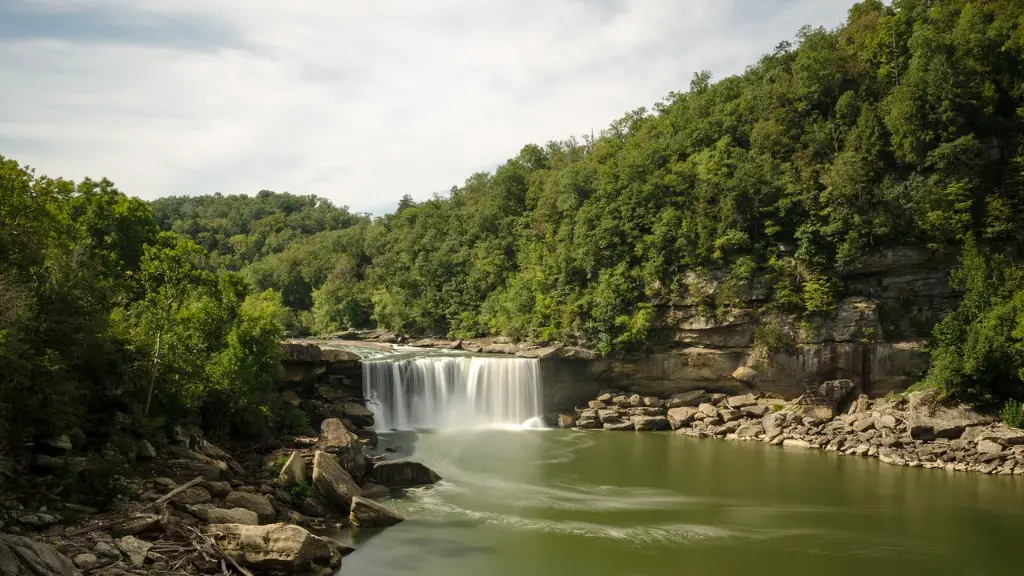The Mississippi River is a natural resource that supports many diverse ecosystems, agricultural and commercial uses, and offers a variety of recreational opportunities. Despite its essential importance, the Mississippi River is suffering from a range of environmental challenges, some of the most serious being water pollution, sediment erosion and invasive species. All of these issues are threatening the health and long-term sustainability of the river.
Water pollution is a major issue on the Mississippi River. Years of agricultural and industrial runoff, sewage, and oil spills have contaminated the water. As a result, fish and wildlife are being harmed by toxic chemicals in the water, such as lead and mercury. In addition, the polluted water affects recreational activities, making them dangerous and harmful to people’s health.
The Mississippi River is also being affected by sediment erosion. Rainfall and certain agricultural practices are eroding land along the riverbanks, leading to the erosion of the riverbed itself. This process increases water turbidity, which affects the clarity and quality of the water. It also destabilizes fish and wildlife habitats, leading to the death of aquatic species and decreased diversity.
Invasive species are yet another threat to the Mississippi River. Non-native aquatic species, such as carp, can be aggressive invaders that disrupt native ecosystems and food webs. They can also compete with native species for resources and reduce their populations. Furthermore, invasive species can damage infrastructure, such as water turbines and artificial habitats, disrupting water supply and recreational activities.
Experts warn that drastic action is needed if the ecological and socio-economic benefits of the Mississippi River are to be maintained. There are a number of policies and initiatives, at both the state and federal level, that aim to tackle these environmental issues. These include agricultural regulations, water quality initiatives, and the implementation of technologies such as wastewater treatment systems. However, much more needs to be done in order to ensure the long-term health of the Mississippi River.
The impact of these environmental challenges on the Mississippi River is far-reaching. The economic, social and cultural repercussions can be devastating. People are not only losing their jobs and livelihoods, but the cost of restoring and protecting the river from further degradation can be extremely expensive. In addition, the damage caused to the fragile ecosystems is not easy to repair.
Despite the seriousness of the situation, there is still much that can be done to protect the Mississippi River. To start, individuals and businesses can commit to supporting more sustainable practices, such as reducing water consumption, decreasing agricultural runoff and implementing environmentally-friendly technologies. Additionally, organizations and governments must continue to work together to implement strong policies and regulations in order to effectively reduce water pollution and sediment erosion, and to stop the spread of invasive species.
Agricultural Practices
Agricultural practices in the Mississippi River basin have a significant impact on the health of the river and the ecosystems it supports. Years of intensified agricultural activity, including the overuse of fertilizers and pesticides, have led to increased runoff and sediment erosion, as well as a decline in water and soil quality.
In order to reduce the impact of agricultural practices on the Mississippi, government and business leaders must work together to develop practices and policies that support sustainable agriculture. This includes implementing crop rotation and conservation tillage techniques, establishing protective buffer zones along waterways, and encouraging farmers to adopt techniques and technologies to reduce the use of fertilizer and pesticides.
In addition, organizations such as the Environmental Protection Agency (EPA), Nature Conservancy, and Conservation Fund are leading initiatives to help farmers and landowners adopt more sustainable practices. These initiatives provide funding, technical assistance, and educational resources to help protect the Mississippi River and its ecosystems.
Environmental Regulation
To address the environmental issues facing the Mississippi River, it is important to have strong environmental regulations in place. Federal and state governments must work together to develop regulations that protect the river, its tributaries, and its associated ecosystems.
At the federal level, the EPA and the U.S. Army Corps of Engineers have developed regulations to address water pollution, sediment erosion, and the spread of invasive species. The Clean Water Act and the Endangered Species Act are just two examples of how the federal government is working to protect the Mississippi River and its ecosystems.
At the state level, individual states have developed their own regulations and initiatives to address their unique environmental challenges. For instance, many states have strengthened regulations on agricultural land use and are improving wastewater treatment systems. In addition, the Mississippi River Commission has implemented a number of initiatives to help protect the river and its ecosystems, including the Mississippi River Restoration initiative and the National Mississippi River Corridor Conservation Program.
Awareness and Education
In order to protect the Mississippi River, it is essential to raise public awareness and educate citizens about the environmental issues facing the river. Organizations such as American Rivers, the National Wildlife Federation, and River Network are leading initiatives to raise public awareness and educate people about the importance of the river and its associated ecosystems.
These organizations are providing educational resources and materials to schools and community groups, as well as organizing events and workshops to spread the word about the river. Additionally, they are working with local governments and businesses to promote the use of more sustainable practices, including water conservation and pollution prevention measures.
Public awareness and education play a critical role in protecting the Mississippi River. Without a better understanding of the environmental problems facing the river, and the measures people can take to prevent them, the river and its associated ecosystems will be in danger.
Ecological Restoration
In addition to implementing protective regulations and raising public awareness, it is also important to restore the river’s fragile ecosystems. The Nature Conservancy, U.S. Fish and Wildlife Service, and U.S. Army Corps of Engineers are leading restoration initiatives to rehabilitate the Mississippi River and its ecosystems.
These organizations are working to protect and restore habitats, such as wetlands and riparian areas, as well as reintroducing native species to the river. They are also working to reduce sediment erosion, improve water quality, and prevent the spread of invasive species.
Ecological restoration is an essential tool for solving the environmental problems facing the Mississippi River. Not only does it help protect and restore wildlife habitats, but it also helps to improve water quality and reduce the impact of human activities on the river.
Conclusion
The Mississippi River is facing a range of environmental challenges. Water pollution, sediment erosion and invasive species are threatening the health and sustainability of the river and its associated ecosystems. In order to protect the Mississippi River, it is essential to implement effective policies, raise public awareness and educate citizens, and restore the river’s fragile ecosystems.





